You are using an out of date browser. It may not display this or other websites correctly.
You should upgrade or use an alternative browser.
You should upgrade or use an alternative browser.
Questions for Sir John....azimuth shift/yaw
- Thread starter agc
- Start date
- Status
- Not open for further replies. Please create a new topic or request for this thread to be opened.
As we briefly discussed azimuth shift/yaw as cause for variable V/arrow head in hearts view. How does this affect performance when the hearts look perfect and what will this show in the crown view with reflector technology? Do any systems grade these V''s/arrowheads? And while I have you what is the difference in the Octonus deviation measurements of ca/pa vs. the deviations on helium/sarin scans. I have seen diamonds that appear not as tighly cut than another but the octonus deviation for the supposed looser cut stone can actually be tighter than the tight diamond when looking at octonus theroy measurements. Any enlightenment would be appreciated.
strmrdr
Super_Ideal_Rock
- Joined
- Nov 1, 2003
- Messages
- 23,295
yaw - do a search on yaw in the search box above and you will see find a lot of reading material on it. Including an all out war one of 3 or 4 the others were removed.
My opinion is that minor yaw has no effect and all diamonds have some yaw.
octonus theory measurements are something different.
Normal deviation measurements are in relation to the table.
If the pavilion is tilted in relation to the table or the table is not flat it can throw them off.
octonus theory measures both crown and pavilion in relation to the girdle plane.
In other words if you cut the pavilion off and the crown off from the girdle and measured them separately you would get the octonus theory numbers.
They are almost always tighter than the standard numbers because all diamonds have some tilt or the table isn''t perfectly flat.
They actually can be pretty far off from the standard and still get perfect hearts and excellent performance but it does display excellent workmanship when the octonus theory and the standard numbers are close.
My opinion is that minor yaw has no effect and all diamonds have some yaw.
octonus theory measurements are something different.
Normal deviation measurements are in relation to the table.
If the pavilion is tilted in relation to the table or the table is not flat it can throw them off.
octonus theory measures both crown and pavilion in relation to the girdle plane.
In other words if you cut the pavilion off and the crown off from the girdle and measured them separately you would get the octonus theory numbers.
They are almost always tighter than the standard numbers because all diamonds have some tilt or the table isn''t perfectly flat.
They actually can be pretty far off from the standard and still get perfect hearts and excellent performance but it does display excellent workmanship when the octonus theory and the standard numbers are close.
strmrdr
Super_Ideal_Rock
- Joined
- Nov 1, 2003
- Messages
- 23,295
strmrdr
Super_Ideal_Rock
- Joined
- Nov 1, 2003
- Messages
- 23,295
strmrdr
Super_Ideal_Rock
- Joined
- Nov 1, 2003
- Messages
- 23,295
This is the exact same pavilion as above.
The standard numbers measured in relation to the bottom of the image would be very different from above but the octonus theory numbers would be the same as they are measured from the top of the colored part instead of the bottom taking into account the tilt.
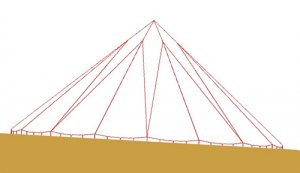
The standard numbers measured in relation to the bottom of the image would be very different from above but the octonus theory numbers would be the same as they are measured from the top of the colored part instead of the bottom taking into account the tilt.

Thanks storm. I have read over those threads numerous times and understand the concept of azimuth shift/yaw but no one has said how it will affect face up performance and what will you see with reflector technology images? Also. how much is too much? With hearts view I have seen "True hearts" meeting all the strict criteria but the arrowheads/V''s (that are slight separated from the point of the hearts) are variable in size with different length sides and does not seem to affect the grading. This apparantly is caused by azimuth shift/yaw and I was thinking can''t be good if it is visually distorting the arrowheads/V''s in the face down view even though the hearts look good in the same view. Any thoughts? Finally, Garry has mentioned that the deviation with helium scans can be off due to a speck of dust with 1 degree of tilt causing 2 degrees of deviation being measured. I may be reading too much into his post but he seem to imply that the octonus numbers are better to go by since they some how compensate for this. He gave an example of a diamond that was clearly tighter on helium than another but he felt the other one was tighter because the octonus number were better. Again thanks for all of you help, I enjoy trying to figure out technical aspects and how that can help in evaluating diamonds.
strmrdr
Super_Ideal_Rock
- Joined
- Nov 1, 2003
- Messages
- 23,295
If there is a greater than expected difference in the octonus theory numbers and the standard numbers then it should be checked as why that happened.
It could be a bad scan it could be dust or it could be that the table is tilted or the crown or pavilion is tilted.
To me tightness includes lack of tilt as long as its a good scan and no dust was under the diamond the standard numbers are the ones that I use to judge tightness.
When jumping into this pool you are well beyond face up appearance and into the science of diamond cut.
Keep in mind that a lot of this stuff don't come close to making a visible difference unless it is more than a bit out of line.
Given 2 diamonds both with excellent face up arrows with the same angles and minor facets but one has bad hearts due to yaw there isn't a person on earth who will see the difference except in a h&a scope with the diamond upside down.
I repeat it is impossible to cut diamonds without measurable yaw and tilt using current technology.
The measuring tools are far beyond the cutting tools.
It is amazing how close precision cutters like Paul's Infinity and 3 or maybe 4 others can come to it however.
It could be a bad scan it could be dust or it could be that the table is tilted or the crown or pavilion is tilted.
To me tightness includes lack of tilt as long as its a good scan and no dust was under the diamond the standard numbers are the ones that I use to judge tightness.
When jumping into this pool you are well beyond face up appearance and into the science of diamond cut.
Keep in mind that a lot of this stuff don't come close to making a visible difference unless it is more than a bit out of line.
Given 2 diamonds both with excellent face up arrows with the same angles and minor facets but one has bad hearts due to yaw there isn't a person on earth who will see the difference except in a h&a scope with the diamond upside down.
I repeat it is impossible to cut diamonds without measurable yaw and tilt using current technology.
The measuring tools are far beyond the cutting tools.
It is amazing how close precision cutters like Paul's Infinity and 3 or maybe 4 others can come to it however.
- Joined
- Aug 15, 2000
- Messages
- 19,185
AGC if the table is not aligned with the girdle it should be treated as a minor symmetry variation. Optically speaking a 1 degree tilt in table (which is common because of dust under the table when the stone is placed in the pot to have the pavilion polished) will only cause an imperceptable difference in appearance.
But labs get a report from their sarin scanner that shows the culet is way off center and the crown and pavilion angles are off by 2 dgrees - so they down grade the stones sym from Excellent to say Good.
This is an example here where the stone was given Good by GIA but it showed passable H&A''s:
http://www.gemology.ru/cut/english/symmetry/6.htm
But labs get a report from their sarin scanner that shows the culet is way off center and the crown and pavilion angles are off by 2 dgrees - so they down grade the stones sym from Excellent to say Good.
This is an example here where the stone was given Good by GIA but it showed passable H&A''s:
http://www.gemology.ru/cut/english/symmetry/6.htm
- Joined
- May 1, 2008
- Messages
- 3,563
Hi AGC. I was out of town for the last several days; sorry for the delay. I thank Strm for answering on my behalf. His input, and Garry's, has covered most of what I would offer. Some thoughts below...
>
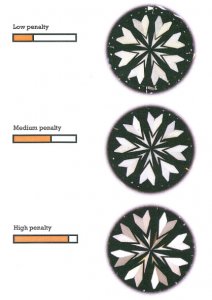
In the terms we are discussing this is beyond performance and into areas of micro-cut and, just as much, micro-tolerance (in terms of 3D scanner accuracy, calibration and scan corruption) and even subtle symmetry issues such as the tilted table examples above. The link Garry provided is one most Pricescopers have bookmarked, though elite fine-make manufacturers with new machinery are not prone to such mistakes as those factories using older equipment.Date: 7/27/2008 12:35:08 PM
Author: agc
As we briefly discussed azimuth shift/yaw as cause for variable V/arrow head in hearts view. How does this affect performance when the hearts look perfect and what will this show in the crown view with reflector technology?
Not in terms of performance. In terms of the traditional H&A pattern for its own sake HRD does grade "Balanced V's." Here is an excerpt and a graphic (acknowledgment to HRD).Do any systems grade these V's/arrowheads?
>

- Joined
- May 1, 2008
- Messages
- 3,563
Important note: What we are talking about is well beyond face-up appearance. New readers please breathe easy. We''re now geeking out in what has been called "nano-tech" territory.Date: 7/27/2008 12:35:08 PM
Author: agc
...And while I have you what is the difference in the Octonus deviation measurements of ca/pa vs. the deviations on helium/sarin scans. I have seen diamonds that appear not as tighly cut than another but the octonus deviation for the supposed looser cut stone can actually be tighter than the tight diamond when looking at octonus theroy measurements. Any enlightenment would be appreciated.

The notion of "tightness" of proportions is arguable territory. “Scanner tightness” implies (for example) a pavilion where all eight mains were successfully cut at, say, 40.8 degrees precisely. This is extremely difficult and rare to achieve. In some cases it’s not even possible because of natural properties in a diamond crystal. Then of course, even our best 3D scanners are subject to some slight micro-level of error.
"Visual tightness” implies a tight optical result even when "scanner tightness" ranges a few tenths above and below 40.8 degrees. This is also extremely difficult to achieve; in our pavilion main example as long as the opposite facet pairs average out to 40.8 degrees apiece the resulting optical effect is the same as "scanner tightness."
Here are some graphics:
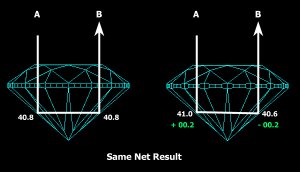
- Joined
- May 1, 2008
- Messages
- 3,563
Rudimentary examples. Both diamonds PA = 40.8 (40.6-41.0)
An example of unbalanced Vs; when opposite pavilion main pairs do not average the main angle (40. and lower halves are inconsistent.
and lower halves are inconsistent.
An example of balanced Vs; when opposite pavilion main pairs average the main angle and lower halves are consistent.
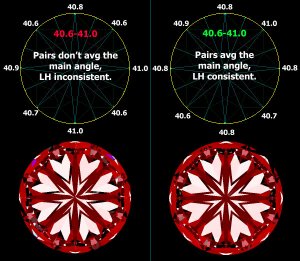
An example of unbalanced Vs; when opposite pavilion main pairs do not average the main angle (40.
An example of balanced Vs; when opposite pavilion main pairs average the main angle and lower halves are consistent.

- Joined
- May 1, 2008
- Messages
- 3,563
- Joined
- Aug 15, 2000
- Messages
- 19,185
John in the case of the HRD grading with a high penalty - is this stone still a pass for H&A''s from HRD?Date: 7/27/2008 9:38:38 PM
Author: John Pollard
Hi AGC. I was out of town for the last several days; sorry for the delay. I thank Strm for answering on my behalf. His input, and Garry''s, has covered most of what I would offer. Some thoughts below...
In the terms we are discussing this is beyond performance and into areas of micro-cut and, just as much, micro-tolerance (in terms of 3D scanner accuracy, calibration and scan corruption) and even subtle symmetry issues such as the tilted table examples above. The link Garry provided is one most Pricescopers have bookmarked, though elite fine-make manufacturers with new machinery are not prone to such mistakes as those factories using older equipment.Date: 7/27/2008 12:35:08 PM
Author: agc
As we briefly discussed azimuth shift/yaw as cause for variable V/arrow head in hearts view. How does this affect performance when the hearts look perfect and what will this show in the crown view with reflector technology?
Not in terms of performance. In terms of the traditional H&A pattern for its own sake HRD does grade ''Balanced V''s.'' Here is an excerpt and a graphic (acknowledgment to HRD).Do any systems grade these V''s/arrowheads?
<< The center pattern consisting of eight V''s should be well balanced. A disturbance of the symmetry in the V pattern results in a penalty proportional to the disturbance. An upperlimit on the penalty prevents immediate rejection. >>
- Joined
- May 1, 2008
- Messages
- 3,563
Thanks! It's a question with several answers. My experience with Helium is limited. It's the most accurate of the scanners but nowhere near as in-use as Sarin and Ogi. Garry or Serg; can you tell us how many sellers other than Rhino are using them in the US?Date: 7/27/2008 9:54:59 PM
Author: agc
Great to have you back. On helium scan, how much pavilion azimuth deviation from ideal would you expect to see to give you each of the three imagines you showed for low, med, high penalty? Just trying to get a feel for the range.
In basic terms (performance) you don't want much deviation in the pavilion. Those mains are the engines driving light return. There is more forgiveness in the crown - much more. When talking about patterning it's just more sensible to look at the hearts image, which is what those grading H&A do. A basic scan shows deviation for the mains (crown or pavilion) but unless you have the full manufacturer's report or 3D scan the numbers don't tell you much...and where Helium is more reliable most common operators of OGI and Sarin are not trying to create accuracy down to the X.XX degree. It's just not in-demand.
Even then, as seen in the examples above, a diamond can show a range of several tenths deviation in the pavilion but still be "optically tight." Alternately, those mains can be "scanner perfect" but inconsistencies in the lower halves distort the patterning. That is why pictures rule and numbers drool: A hearts image will reveal optical tightness as long as you don't have that rare tilted table. A scan-by-the-numbers can tell you only so much (dust on the platform, calibration, given error). Until we invent the perfect scanner (and even then) actual photos, from IS-ASET to patterning, are more practical in terms of telling the real story.
Remember that diamond cutters at the top of their craft are chasing the optical results. "Scanner tight" is one thing, but there is as much (some would say more) skill in cutting that preserves the diamond's "perfect" optics if graining or an inclusion caused a necessary deviation as there is in trying to cookie-cut to one single number all-around. In fact I've heard Garry, among others, say that about those cutters who are adept at swindling/cheating too - but that's a different conversation.
- Joined
- May 1, 2008
- Messages
- 3,563
Hi Garry. It''s a borderline example. For future reference on these charts, orange means borderline and red means rejected. Here is a reject example from their guidelines (acknowledgment to HRD).Date: 7/27/2008 10:04:36 PM
Author: Garry H (Cut Nut)
John in the case of the HRD grading with a high penalty - is this stone still a pass for H&A''s from HRD?
By the way sir, I have a fantastic little S.Blanc from New Zealand that''s just finished chilling so I''m off for a bit. Talk with you guys later.

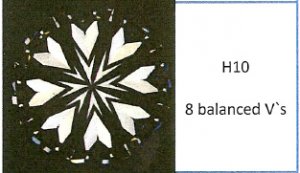
strmrdr
Super_Ideal_Rock
- Joined
- Nov 1, 2003
- Messages
- 23,295
I don''t buy into there being the exact same result as the pavilion facet interaction is more complex than the simple model presented.Date: 7/27/2008 9:50:20 PM
Author: John Pollard
''Visual tightness” implies a tight optical result even when ''scanner tightness'' ranges a few tenths above and below 40.8 degrees. This is also extremely difficult to achieve; in our pavilion main example as long as the opposite facet pairs average out to 40.8 degrees apiece the resulting optical effect is the same as ''scanner tightness.''
Here are some graphics:
Here are the virtual facet charts for a RB and a solasfera from another thread.
As you can see there are many more interactions than the simple model presented can account for between the facets.
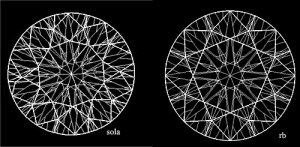
strmrdr
Super_Ideal_Rock
- Joined
- Nov 1, 2003
- Messages
- 23,295
A lesson on the power of virtual facets is here:
https://www.pricescope.com/community/threads/my-asscher-looks-so-cool-in-low-light-anyone-else.83928/
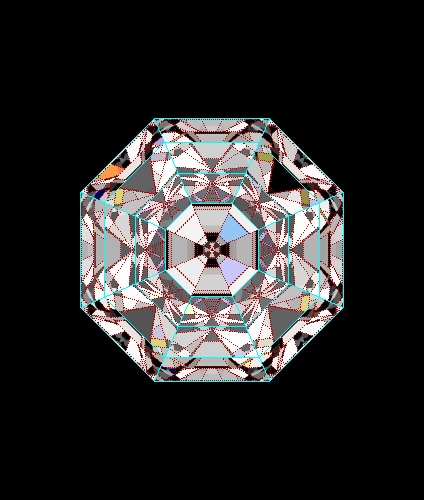
https://www.pricescope.com/community/threads/my-asscher-looks-so-cool-in-low-light-anyone-else.83928/

- Joined
- Aug 15, 2000
- Messages
- 19,185
So Sir John, if you can still comprehend me, with a skin full of NZ cat''s pee, you really mean all 3 of these will pass and be noted on an HRD report as being hearts for H&A''s????? Surely they will also have some warning as to the grade of H&A''s?Date: 7/27/2008 10:25:28 PM
Author: John Pollard
Hi Garry. It''s a borderline example. For future reference on these charts, orange means borderline and red means rejected. Here is a reject example from their guidelines (acknowledgment to HRD).Date: 7/27/2008 10:04:36 PM
Author: Garry H (Cut Nut)
John in the case of the HRD grading with a high penalty - is this stone still a pass for H&A''s from HRD?
I really can not wait to get a full report on this new system?
Date: 7/27/2008 10:25:28 PM
Author: John Pollard
By the way sir, I have a fantastic little S.Blanc from New Zealand that''s just finished chilling so I''m off for a bit. Talk with you guys later.
Hope the SB is not to dry for your taste - Drena and I would not choose other than NZ Marlborough for that variety

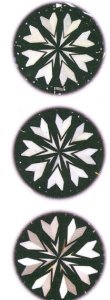
- Joined
- Sep 2, 2002
- Messages
- 2,859
The HRD-system has 10 criteria when judging the Hearts-pattern, 8 when judging the Arrows-pattern. Each individual penalty ranges from 0 to 1, and they are summed up separately for hearts and for arrows. The total of each group of penalties may not surpass 1.Date: 7/28/2008 3:16:20 AM
Author: Garry H (Cut Nut)
So Sir John, if you can still comprehend me, with a skin full of NZ cat''s pee, you really mean all 3 of these will pass and be noted on an HRD report as being hearts for H&A''s????? Surely they will also have some warning as to the grade of H&A''s?Date: 7/27/2008 10:25:28 PM
Author: John Pollard
Hi Garry. It''s a borderline example. For future reference on these charts, orange means borderline and red means rejected. Here is a reject example from their guidelines (acknowledgment to HRD).Date: 7/27/2008 10:04:36 PM
Author: Garry H (Cut Nut)
John in the case of the HRD grading with a high penalty - is this stone still a pass for H&A''s from HRD?
I really can not wait to get a full report on this new system?
That is in short. I still did not get sufficient extra information to give a full report.
- Joined
- Aug 15, 2000
- Messages
- 19,185
Thanks Paul, but it seems that I have the same small snippets of info that add up to the idea that there is a system, but it is still a secret system?Date: 7/28/2008 4:19:56 AM
Author: Paul-Antwerp
The HRD-system has 10 criteria when judging the Hearts-pattern, 8 when judging the Arrows-pattern. Each individual penalty ranges from 0 to 1, and they are summed up separately for hearts and for arrows. The total of each group of penalties may not surpass 1.
That is in short. I still did not get sufficient extra information to give a full report.
Are HRD being taught politics by the GIA? Why not produce a simple report the way Peter Yantzer does for AGS?
- Joined
- May 1, 2008
- Messages
- 3,563
AGC’s original question was about the hearts view, reflectors and whether this stuff is graded. The resulting optical effect as seen in the H&A viewer and in terms of grading hearts is the same. I could certainly go into “nano-tech” areas - as could many of us who own DiamCalc - but in terms of the hearts view, seen in a live viewer for purposes of grading the patterning my answer stands.Date: 7/28/2008 12:35:01 AM
Author: strmrdr
I don''t buy into there being the exact same result as the pavilion facet interaction is more complex than the simple model presented.
Here are the virtual facet charts for a RB and a solasfera from another thread.
As you can see there are many more interactions than the simple model presented can account for between the facets.
Of course I was just playing the dealer’s game. If I knew you were going to raise table stakes to virtual facets I’d have told the missus it was an all-nighter.

- Joined
- May 1, 2008
- Messages
- 3,563
It was the Giesen from Marlborough, but you likely guessed that. Not too dry at all - especially when paired with grapes & cheese.Date: 7/28/2008 3:16:20 AM
Author: Garry H (Cut Nut)
Date: 7/27/2008 10:25:28 PM
Author: John Pollard
By the way sir, I have a fantastic little S.Blanc from New Zealand that''s just finished chilling so I''m off for a bit. Talk with you guys later.
Hope the SB is not to dry for your taste - Drena and I would not choose other than NZ Marlborough for that variety

- Joined
- May 1, 2008
- Messages
- 3,563
I don’t get the impression it’s secret Garry, just not widely published yet.Date: 7/28/2008 7:37:33 AM
Author: Garry H (Cut Nut)
Thanks Paul, but it seems that I have the same small snippets of info that add up to the idea that there is a system, but it is still a secret system?Date: 7/28/2008 4:19:56 AM
Author: Paul-Antwerp
The HRD-system has 10 criteria when judging the Hearts-pattern, 8 when judging the Arrows-pattern. Each individual penalty ranges from 0 to 1, and they are summed up separately for hearts and for arrows. The total of each group of penalties may not surpass 1.
That is in short. I still did not get sufficient extra information to give a full report.
Are HRD being taught politics by the GIA? Why not produce a simple report the way Peter Yantzer does for AGS?
Or...they may have seen the way AGS' open reporting and transparency has occasionally resulted in negativity rather than appreciation for their willingness to share.

strmrdr
Super_Ideal_Rock
- Joined
- Nov 1, 2003
- Messages
- 23,295
Date: 7/28/2008 1:05:04 PM
Author: John Pollard
Date: 7/28/2008 12:35:01 AM
Of course I was just playing the dealer’s game. If I knew you were going to raise table stakes to virtual facets I’d have told the missus it was an all-nighter.
Well I figured since I have a good overview of virtual facets posted and the OP seems interested in getting into this level it was a good time to point it out.
Anyone who has designed a diamond and is good at it will tell you that virtual facets, VF interaction, and VF light reaction(controlled by angles) is the key to diamond appearance in any given lighting condition.
- Status
- Not open for further replies. Please create a new topic or request for this thread to be opened.
Share:
How Are Diamonds Made? Natural vs Lab-Created Explained How Are Diamonds Made? Natural vs Lab-Created Explained - 08/05
How Are Diamonds Made? Natural vs Lab-Created Explained - 08/05

Top Wedding Ring Brands for Every Style and Budget
Top Wedding Ring Brands for Every Style and Budget - 08/05
Where to Buy Lab Grown Diamonds: Best Places Compared
Where to Buy Lab Grown Diamonds: Best Places Compared - 08/05





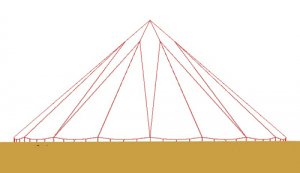
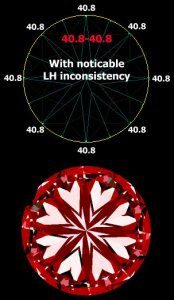

300x240.png)